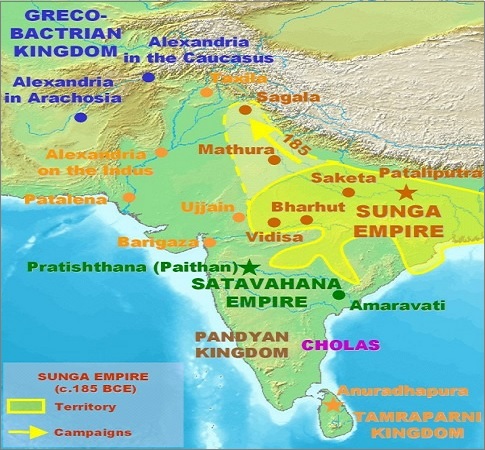Post Mauryan India: Sungas Dynasty, Satavahanas
by Devender
0 2089
The successors of Ashoka were not able to keep intact the vast Mauryan empire created by Ashoka and many provinces declared themselves independent. The N-W India got out of their hands and went under a series of attacks from foreign invaders.
Kalinga also declared itself independent and in the south, satavahanas also declared their independent rule. As an outcome of these events, the Mauryan empire was limited to only Gangetic valley which was soon replaced by the Sunga dynasty.
Sunga Dynasty
Maurya's commander in chief, Pushyamitra Sunga laid the foundation of the Sunga Dynasty by assassinating the last Mauryan ruler and claiming the throne. Bactrian Greeks attacked NW India and advanced up to Patliputra. They occupied it for some time but it was reclaimed back by Pushyamitra Sunga. He also fought against the Kharvela of Kalinga who invaded North India.
Pushyamitra Sunga was a follower of Brahamanism and was against Buddhism but he did love Buddhist art. That's why he renovated the Buddhist monuments of Bharut (MP) & Sanchi during his reign. After his death, his son named Agnimitra took the throne.
Devabhuti was the last ruler of the Sunga Dynasty and he was murdered by his own minister Vasudeva Kanva, who was the founder of the Kanva Dynasty. The Kanva dynasty ruled for around 45 years until they were removed by the Satavahanas. After some time, Guptas came to Magadha.

- Effect of Sungas:
- They defended Gangetic valley from foreign invaders
- Sunga was able to revive brahamanism, vaishnavism, horse sacrifice & the use of the Sanskrit language
- Sunga rule was a splendid expectation of the brilliant period of Guptas
Satavahanas
Satavahanas declared their independent rule in Deccan after the decline of the Mauryan empire. They ruled for around 450 years and were known as Andhras whose capital was at Paithan/Pratisthan on the river Godavari. Simuka was known as the founder of Satavahanas dynasty and he was succeeded by Krisha who extended the kingdom in the west to Nashik.
Gautamiputra Satkarni is known as the greatest ruler of this dynasty. He used to address himself as the only Brahamana and he was a true admirer of Brahamanism but he also used to donate to Buddhists. The Nashik & Nanaghad inscriptions tell us about his achievements. After his death, his son Vashishtaputra Pulamayi became the ruler. He issued coins with the inscription of images of ships that shows naval power & maritime trade of Satavahanas.
The last great ruler of this dynasty was Yajna Sri Satkarni. He recovered Malwa & the northern coast of Konkan from Shaka rulers. The period of Satavahanas encountered a lot of trade growth overseas. The administration of Satavahanas was very similar to the Mauryans.
Satavahanas official language was Prakrit and they issued silver coins known as Karshpanas while Issuing Lead coins for trade. They were the ones who started practicing of giving tax-free villages to Brahamanas and Monks. They were able to revive Brahamanism along with the practice of Aswamegha & Rajasuya sacrifices.
They had ports on both the east and west sides. Their kingdom had 3 grades of feudatories: Raja, Mahabhoja, and Senapati. Kataka and Skandhvaras were made Military Regiments as the administrative centers for kings during wartime.
Satavahanas formed many Chaityas (Temples) and Viharas (Residences for monk). They were succeeded by Ikshvakus.

Share:







Comments
Waiting for your comments